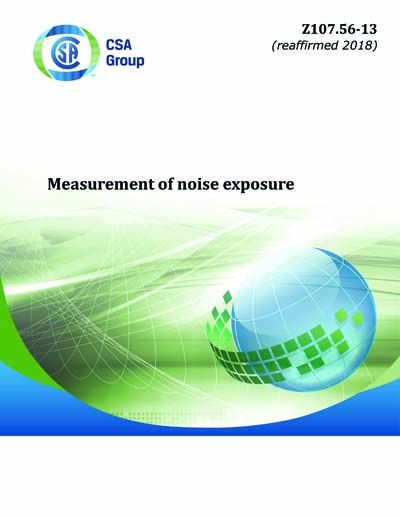Historical
CSA Z107.56-2013 (R2018)
Measurement of noise exposure
Preface
This is the fourth edition of CSA Z107.56, Measurement of noise exposure, which is part of the CSA Z107 series of Standards on workplace noise control, vibration control, and occupational audiology. This edition supersedes the third edition, entitled Procedures for the measurement of occupational noise exposure, published in 2006, and previous editions published in 1994 and 1986.Scope
1.1 This Standard describes procedures for determining the occupational noise exposure level of workers (Lex,T) using sampling techniques. Lex,T represents the long-term noise exposure of workers and is calculated from measurements of Leq,t in the workplace. Notes: 1) Noise exposure has been expressed as % dose in the past. However, the use of Leq,t is recommended, as it is more convenient and less likely to be misunderstood. 2) The procedures in this Standard normally form part of any occupational hearing conservation program. Users of this Standard should be proficient in noise measurement. 1.2 This Standard provides procedures for measuring the occupational noise exposure from all types of noise, e.g., continuous noise, tonal noise, and impulsive noise. All types of noise (including impulsive noise) are included in a single equivalent sound level for an individual or group. Note: Although this Standard was written to measure noise exposure in the workplace, it can equally be used to measure non-occupational noise exposures, including those from music players, radios or other sound reproduction devices. 1.3 This Standard can be used to determine the noise exposure level of individuals (Lex,T) or extended to groups (LGroup) with similar noise exposures. It can also be used to measure the average noise (Leq,t) from a given job or activity (e.g., operating a particular machine). 1.4 This Standard provides for measurements in terms of equivalent sound level, Leq,t (3 dB exchange rate), and calculation of noise exposure level, Lex,T, regardless of noise type. Procedures for calculating related quantities, such as % dose, are provided. This Standard may also be used to measure LOSHA (5 dB exchange rate) and calculate the associated indices as shown in Annex D. In this case, the results may not be a good representation of exposure to impulsive noise. Note: Measurements taken in Leq cannot be converted to LOSHA , or vice versa, unless the time distribution of sound levels is known. 1.5 This Standard provides procedures to determine the noise exposure level of workers with a given precision. In certain cases, the user is only interested in determining that a worker's exposure is above or below the criterion level. Therefore, the procedures in this Standard can be less rigorously applied when the noise exposure level is either far above or far below the criterion level. 1.6 In CSA Standards, "shall" is used to express a requirement, i.e., a provision that the user is obliged to satisfy in order to comply with the standard; "should" is used to express a recommendation or that which is advised but not required; "may" is used to express an option or that which is permissible within the limits of the standard; and "can" is used to express possibility or capability. Notes accompanying clauses do not include requirements or alternative requirements; the purpose of a note accompanying a clause is to separate from the text explanatory or informative material. Notes to tables and figures are considered part of the table or figure and may be written as requirements. Annexes are designated normative (mandatory) or informative (non-mandatory) to define their application.CSA America, Inc. [csa]

